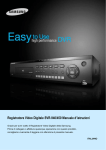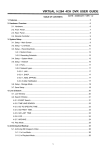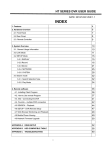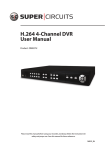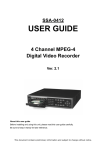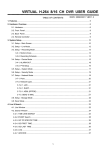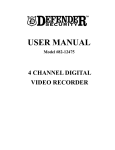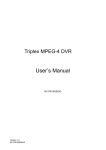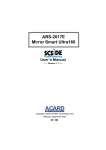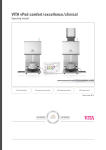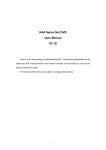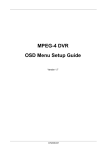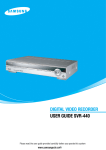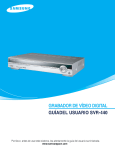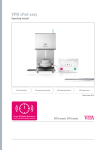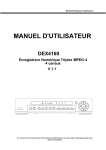Download Owners Manual - Platt Electric Supply
Transcript
USER GUIDE 4 Channel MPEG-4 Triplex Digital Video Recorder (Ver. 2.1) About this user guide Before installing and using this unit, please read this user guide carefully. The specifications and information are subject to change without notice for quality improvement. Safety Precautions Explanation of Graphical Symbols This symbol indicates the presence of important operating and maintenance (servicing) instruction in the literature accompanying the product. This symbol indicates the presence of unprotected ”dangerous voltage” within the product’s enclosure that may be of sufficient magnitude to constitute a risk of electric shock to persons. Cautions This product has multiple-rated voltages (110v and 220v). See installation instructions before connecting to the power supply. This product uses a Lithium battery. To avoid of risk of explosion, do not replace the battery on the main board by anything other than a Lithium battery. Dispose of used batteries according to the manufacturer’s instructions. This equipment and all communication wirings are intended for indoor use only. To reduce the risk of fire or electric shock, do not expose the unit to rain or moisture. 2 Warnings Installation and servicing should be performed only by qualified and experienced personnel. Power off the DVR when connecting cameras, audio or sensor cables. The manufacturer is not responsible for any damage caused by improper use of the product or failure to follow instructions for the product. The manufacturer is not responsible for any problems caused by or resulting from the user physically opening the DVR for examination or attempting to fix the unit. The manufacturer may not be held liable for any issues with the unit if the warranty seal is removed. 3 Contents of DVR package The package contains the main unit and its components as specified below. When you purchase the unit, please check to ensure the components specified below are included. DVR Set Client Software CD (Including Manual) Remote Controller Battery1.5V (AAA x 2EA) Adaptor and Power cable IDE HDD Cable HDD Screws and Rubber rings 4 Compatible HDD Models COMPANY HITACHI MAXTOR SAMSUNG Western Digital Seagate MODEL SIZE RPM BUFFER INTERFACE HDS728080PLAT20 80 GB 7200 RPM 2M E-IDE HDS721680PLAT80 82 GB 7200 RPM 8M E-IDE HDT722516DLAT80 160 GB 7200 RPM 8M E-IDE HDT722516DLAT80 164 GB 7200 RPM 8M E-IDE HDS722525VLAT80 250 GB 7200 RPM 8M E-IDE HDT722525DLAT80 250 GB 7200 RPM 8M E-IDE HDT725025VLAT80 250 GB 7200 RPM 8M E-IDE HDT725032VLAT80 320 GB 7200 RPM 8M E-IDE HDS725050KLAT80 500 GB 7200 RPM 8M E-IDE 6L300R0 300 GB 7200 RPM 16 M E-IDE SP0822N 80 GB 7200 RPM 2M E-IDE SP1604N 160 GB 7200 RPM 2M E-IDE WD1600BB-22GUA0 160 GB 7200 RPM 2M E-IDE WD2000BB-00GUA0 200 GB 7200 RPM 8M E-IDE WD2500BB-00KEA0 250 GB 7200 RPM 8M E-IDE ST3400-15ACE 40 GB 7200 RPM 2M E-IDE ST3800-12ACE 80 GB 7200 RPM 2M E-IDE ST31200-25ACE 120 GB 7200 RPM 2M E-IDE ST31600-22ACE 160 GB 7200 RPM 2M E-IDE ST3300820ACE 300 GB 7200 RPM 8M E-IDE ST3300831ACE 300 GB 7200 RPM 8M E-IDE ST3400832ACE 400 GB 7200 RPM 8M E-IDE ST3400820ACE 400 GB 7200 RPM 8M E-IDE ST3500641A 500 GB 7200 RPM 16 M E-IDE ST3750840ACE 750 GB 7200 RPM 8M E-IDE ST3750640A 750 GB 7200 RPM 16 M E-IDE 5 Specifications VIDEO INPUT 4 composite BNC (NTSC/PAL) – 1.0Vp-p OUTPUT (Selectable) 1 composite BNC (NTSC/PAL) – 1.0Vp-p 1 VGA ALARM INPUT & OUTPUT 4&1 OS RECORD MULTI TASK RTOS COMPRESSION MPEG-4 VIDEO FORMAT NTSC PAL RESOLUTION 352x240, 704x480 352x288, 704x576 RECORDING SPEED MAX. 120fps/4CH(352x240/CH) MAX. 100fps/4CH(352x288/CH) MAX. 30fps/4CH(704X480/CH) MAX. 25fps/4CH(704X576/CH) MODE Manual, Motion, Sensor, and Schedule METHOD By Resolution, fps & Quality TRIPLEX Record, playback and transfer CONTROL UNIT IR Type Remote Control and Front keys SERIAL PORT CONSOLE 1 RS-232C NETWORK DYNAMIC IP Supported by DDNS LAN PORT 1 10/100-base T Ethernet FUNCTIONS Live, Search, P/T/Z/F HDD CAPACITY 1EA Max. 750GB BACKUP NETWORK Still Image & Video data USB STICK Still Image & Video data ELECTRONICAL POWER SOURCE DC +12V Adaptor SPECIFICATION CONSUMPTION About 25W ENVIRONMENTAL TEMPERATURE 5°C ~ 40°C SPECIFICATION HUMIDITY 30% ~ 90% DIMENSION 340(W) X 262(D) X 63(H)mm SIZE 6 INDEX 1. FRONT PANEL AND REMOTE CONTROLLER ........................................................... 10 2. REAR PANEL AND CONNECTIONS............................................................................ 12 3. SETTING UP THE DVR................................................................................................. 13 3-1. Setup - Main Screen ................................................................................................................................ 13 3-2. Setup – Live Mode ................................................................................................................................... 15 3-3. Setup – Recording Mode ........................................................................................................................ 16 3-3-1. Motion Zones ...................................................................................................................................... 17 3-3-2. Recording Schedules ......................................................................................................................... 18 3-4. System ...................................................................................................................................................... 19 3-5. Network .................................................................................................................................................... 22 3-5-1. Ports.................................................................................................................................................... 23 3-5-2. Network types ..................................................................................................................................... 24 3-5-2-1. LAN.................................................................................................................................................. 24 3-5-2-2. DHCP .............................................................................................................................................. 24 3-5-2-3. ADSL (PPPOE)................................................................................................................................ 25 3-6. Storage ..................................................................................................................................................... 26 4. LIVE & SEARCH ........................................................................................................... 28 4-1. Live Window............................................................................................................................................. 28 4-2. SEARCH window ..................................................................................................................................... 30 4-2-1. EVENT Search ................................................................................................................................... 30 4-2-2. TIME LINE Search.............................................................................................................................. 31 4-2-3. GO TO ................................................................................................................................................ 32 4-2-4. GO FIRST........................................................................................................................................... 32 4-2-5. GO LAST ............................................................................................................................................ 32 4-2-6. LOG List.............................................................................................................................................. 32 7 4-2-7. ARCHIVE Search................................................................................................................................ 33 4-3. Playback mode ........................................................................................................................................ 34 5. ARCHIVING AND BACKUP .......................................................................................... 35 5-1. Archiving Still images or Video.............................................................................................................. 35 5-2. Backup still images or videos on USB memory stick ......................................................................... 36 5-3. Playing backup file .................................................................................................................................. 36 6. NETWORK – BY AN EXCLUSIVE VIEWER ................................................................. 37 6-1. Overview................................................................................................................................................... 37 6-2. Minimum PC requirements ..................................................................................................................... 38 6-3. Installing the program............................................................................................................................. 38 6-4. Live viewer ............................................................................................................................................... 39 6-5. Search and Playback Viewer.................................................................................................................. 41 6-5-1. Backup................................................................................................................................................ 42 6-6. PC System configuration........................................................................................................................ 42 6-6-1. General ............................................................................................................................................... 42 9-6-2. Site...................................................................................................................................................... 43 9-6-3. Event................................................................................................................................................... 43 9-6-4. Record ................................................................................................................................................ 44 9-6-5. Disk ..................................................................................................................................................... 44 7. NETWORK – BY AN WEB-BROWSER VIEWER ......................................................... 45 7-1. Download Web Brower Viewer and Connection .................................................................................. 45 7-2. Main Features .......................................................................................................................................... 46 7-2-1. Live ..................................................................................................................................................... 46 7-2-2. Search and Playback.......................................................................................................................... 47 8 APPENDIX ........................................................................................................................ 48 A. How to open TCP port on Router? ........................................................................................................... 48 B. How to access DVR from Remote PC?.................................................................................................... 48 B-1. How to access DVR from Remote PC in the same local network?....................................................... 48 B-2. How to access DVR from Remote PC with IP address?....................................................................... 49 B-3. How to access DVR from Remote PC with DDNS service when DVR is linked on Dynamic IP? ........ 49 9 1. Front Panel and Remote controller The following information will help you operate the front panel controls. Figure 1.1 Front panel Table 1.1. Front LED and Port Name POWER HDD USB port Description LED light is on when power is applied to the system. LED light is on when the system is recording video data. There is a USB port located on the left side of the front panel. This USB port is used to archive footage into a USB storage device. (USB 2.0 connector) 10 F/REW Jump 60 seconds backward PLAY/PAUSE Play/Pause F/ADV Jump 60 seconds forward FF Fast Forward SETUP Setup menu screen SEQ Sequence of Full or Quad view RECORD Manual recording SEARCH Search menu screen DIRECTION Direction or number 1 to 4 SELECT Enter ID DVR ID (ID Button + DVR ID number) Figure 1.2 Remote controller ESC Esc NUMBER Channel 0 to 9 Table 1.2. Description of remote controller 11 2. Rear Panel and Connections Figure 2.1. Rear Panel Table 2.1. Rear panel connections Connection VIDEO IN VIDEO OUT VGA RS-232 Purpose Four connectors for video input. Connect camera output to Video-in (NTSC/PAL) Composite video output in NTSC or PAL format Connector for VGA monitor For engineering use only Connector for sensor device connection. 4 sensors can be connected to the equipment sensor 1, 2, 3, 4 are dedicated to Video channel 1, 2, 3, 4, respectively. Either normal open (NO) or normal close (NC) sensor can be selected for each sensor. Simple On/Off switching. SENSOR IN Connect two signal lines of sensor (infrared rays sensor, heat perception sensor, magnetic sensor) to the desired sensor number. (You can set the type-NC or NO- of sensor at “Setup” mode). NOTICE SENSOR inputs need dried contact only. Do not input any electric signal. ALARM OUT LAN DC 12V Connector for alarm device connection. Provides simple On/Off switching using relay. 0.5A/125V, 1A/30V RJ45 connector for LAN connection Apply 12V DC using the DC adaptor supplied with the equipment. Select VGA monitor or CVBS (Composite Video Blanking Sync) monitor. SWITCHES Do not change the setting when the power is on. When the position of the switch is changed, the DVR should be rebooted to apply the new setting. 12 3. Setting up the DVR The following sections detail the initial setup of the DVR 3-1. Setup - Main Screen When you press the SETUP button, the DVR will ask for a password. The default password is 1111, which can be entered by pressing the up button ( ) 4 times and then pressing the SEL button. We recommend you protect the system by assigning a new password immediately. Figure 3.1.1. Setup menu screen 13 SETUP LIVE OSD SEQUENCE SEQ-DWEL TIME EVENT BEEP OSD CONTRAST CHANNEL DISPLAY, SEQ LIST, BRIGHTNESS, CONTRAST, HUE, SATURATION VGA SCREEN MODE ERROR ALARM RECORD RESOLUTION CHANNEL Frame rate, Quality, Recoding, Motion zone, Motion sensitivity, Sensor type, Pre-Record, Post-Event Record, Alarm, Alarm Duration, Schedule SYSTEM DVR ID DESCRIPTION LOAD DEFAULT ADMIN PASSWORD NETWORK PASSWORD DATE FORMAT SET DATE & TIME LANGUAGE REMOTE CONTROLLER ID DLS NETWORK PORT CLIENT ACCESS BANDWIDTH SAVING NE TWORK TYPE DDNS SEND E-MAIL STORAGE OVERWRITE FORMAT USB UPGRADE SAVE SETUP TO A USB LOAD SETUP FROM A USB VDEO DELETE DELETE VIDEO AFTER Table 3.1.1. Setup menu configuration 14 3-2. Setup – Live Mode Table 3.2.1. Menu items in LIVE mode setup Item OSD SEQUENCE SEQ-DWELL TIME EVENT BEEP Description Enable/disable on-screen-display. Enable/disable sequential display of video channels in full screen mode Dwell time for each cannel display in sequential display mode Enable/Disable internal beep alert sound. OSD CONTRAST Set the visibility level of the On Screen Display (OSD) CHANNEL Select the channel for applying the following settings. DISPLAY Enable/disable display of the video channel in live display mode SEQ LIST Enable/disable the specified channel to be included in sequential display mode. BRIGHTNESS CONTRAST HUE Change the brightness value for the specified channel Change the contrast value for the specified channel Change the hue value for the specified channel SATURATION Change the saturation value for the specified channel VGA SCREEN Select VGA screen mode as either FULL or Normal. MODE ERROR ALARM NOTE: If the mode is changed, the system will reboot. Enable/Disable alarm for video loss or HDD fail. Figure 3.2.1. Live mode setup screen 15 3-3. Setup – Recording Mode Table 3.3.1. Menu items in Recording mode setup Menu item RESOLUTION Description Set resolution to either 704x480(NTSC)/704X576(PAL) or 352x240(NTSC)/352X288(PAL). CHANNEL Select the channel for applying the following settings. Set the frame rate for the specified channel. The sum of the frame rate values FRAME RATE from each channel cannot exceed maximum frame rates for a particular recording resolution. Typical values of the maximum frame rate for NTSC video are 120/100fps for 352x240(NTSC)/352X288(PAL) and 30/25 fps for 704x480(NTSC)/704X576(PAL) QUALITY Select the recording quality for the specified channel from normal, high, and superior. RECORDING Assign the recording mode for each channel. Recording modes: Continuous, Motion, Sensor, Schedule, and Disable. MOTION ZONE Select Full Zone or Partial Zone for motion sensing. If the Partial Zone is selected, screen will be change as shown in figure 3.3.2. MOTION SENSITIVITY SENSOR TYPE Set the motion sensitivity for the specified channel. Control the motion sensitivity from 1 to 9. Set the type of sensor for the specified channel from none, N/O (normal open), and N/C (normal closed). PRE RECORD Enable/disable pre-event recording. Pre-event recording time is 5 sec and only intra-frames are recorded for pre-event recording. POST EVENT Set post event recording time duration for the specified channel RECORD ALARM ALARM DURATION SCHEDULE Enable/disable alarm generation for the specified channel. Set alarm time duration for the specified channel. Set recording schedule. If this menu item is selected, screen will change as shown in figure 3.3.3. 16 Figure 3.3.1. Recording mode setup screen 3-3-1. Motion Zones By selecting Partial Zone in the Motion Zone menu, users can set-up the motion sensing zones in the screen shown in figure 3.3.2. Move around each rectangular zone using 4 direction key buttons and press SEL button to include the rectangular region as part of the motion sensing zone. The rectangular blocks included as part of the motion zone are indicated by changing the color of the blocks. Figure 3.3.2. Motion Zone selection screen 17 3-3-2. Recording Schedules To set up a recording schedule, select SCHEDULE in the RECORD menu. Use the arrow buttons to navigate through the items and set the recording. [ALL]: Selected recording mode using the SEL button is applied to the entire time zone and all channels. [SUN to SAT]: Selected recording mode using the SEL button is applied to the entire time zone for the specified channel. [Vertical Bar “ | “]: Selected recording mode using the SEL button is applied to the entire channel for the selected time zone. Each vertical bar “ | “ corresponds to one hour. [- Individual Block of Time]: Selected recording mode using the SEL button is applied to the selected 1-hour increment for the selected channel. [SEL]: The recording mode can be selected using the SEL button. [COPY FROM to COPY TO]: Setup values of recording mode for the selected channel can be copied for another channel setup. Figure 3.3.3. Schedule recording setup screen 18 3-4. System Table 3.4.1. Menu items in System Setup screen Item Description DVR ID The name of the system. Press the SEL button and move through the position for each alphanumeric character by pressing the LEFT and RIGHT buttons. UP/DOWN buttons are used to change character for each location. DESCRIPTION LOAD DEFAULT Press SEL to see system information. Choose OFF or ON. If selecting ON, press the SEL button to load defaults. ADMIN Set the password for the administrator. Once this menu is selected, the DVR will ask PASSWORD you current password and new password. Follow the procedure provided by the DVR. The password numbers (1,2,3,4) can be input by using direction keys. The default password is 1111. NETWORK Set the password of network client. Once this menu is selected, the DVR will ask PASSWORD you current password and new password. The DVR will guide you through the entire process of setting up the user password. The password numbers (1,2,3,4) can be input by using direction keys. The default password is 1111. DATE FORMAT SET DATE & TIME LANGUAGE REMOTE CONTROLLER ID Select the preferred date and time display. Set the present date and time. If DLS function is ON, user can not enter into this menu and change data and time. Select a language. Select a ID of remote controller. 1. Select ID from 1 to 9. 2. Press the same number as ID set in DVR on a remote controller 3. Then icon will be displayed on Live screen of DVR that respond to the remote controller. DLS User can set to ON or OFF for DLS(Daylight Saving) by using LEFT or RIGHT button. After selecting ON, move the cursor to BEGIN(MM/DD/HH)field and press the SELECT button to set the start time of DLS. And move to END(MM/DD/HH)field to set the stop time of DLS by using UP or DOWN button. CAUTION: -DLS can’t start from 23:00 -DLS can’t be applied, if the date of BEGIN and END is same. 19 Figure 3.4.1. System setup screen Figure 3.4.2. DVR ID setup screen Figure 3.4.3. DVR information display screen 20 Figure 3.4.4. Date & Time setup screen. 21 3-5. Network Set up your network parameters on the Network Setup screen. Table 3.5.1. Menu items in Network Setup screen Item PORT CLIENT ACCESS BANDWIDTH SAVING Description Port number (Default: 5445) Enable/Disable remote access through client software. Enable/Disable only key frame transmission. “ON” mode is favorable for use of low network bandwidth. Mostly, set “OFF” for normal use. NETWORK TYPE Set the type of network connection. Options are: LAN, DHCP, ADSL Note. Other parts of the Network Setup screen change depending on what network type you select. DHCP Sets to use HDCP (If this is selected, DVR automatically get IP varying from time to time from network.) ADSL (PPPoE) ID: Registered ID is necessary for ADSL connection. Password: Registered pasword is necessary for ADSL connection. LAN IP: Register IP address that is assigned for DVR. Gateway: Register Gateway that is assigned for DVR. Subnet Mask: Register Subnet Mask that is assigned for DVR. DDNS Enable/disable using domain name address through DDNS server. “ON” mode, DDNS server name appears for domain registration. The DDNS sever name is ns.standalone4ch.com. CAUTION: Do not change this sever name. If this is changed, the DDNS service cannot be used. Registration Check the MAC address of DVR from Setup>System>Description. Please contact a distributor or an installer to register your DVR on a DDNS Server. Register the domain name on DDNS Server. After the domain name and MAC address of the DVR are registered on a DDNS server, user can access the network with their own domain name. 22 ] Figure 3.5.1. Network setup screen 3-5-1. Ports When you connect one or more DVRs to a network through an IP sharing device, each device must have a unique TCP port number for access to each unit from outside the LAN. Also, the IP sharing device must be configured for port forwarding so when each port is accessed on the IP sharing device, it will forward to the appropriate DVR. Note: This port number is listed next to the Port menu option in the Network Setup screen. If you plan to access the DVR units only from within the same LAN, the TCP port does not have to be changed. Network access beyond Router In order to access beyond Router (Firewall), user must open 1 TCP port for Command level, Live channels, and Storage channels. If this port is not open properly, user can not access DVR beyond a router. If DVR sets port number with 5445, user has to open 1 TCP port of 5445. 23 3-5-2. Network types 3-5-2-1. LAN 1. for the use of fixed IP. (See your network administrator if you do not have this information.) 2. When DVR is installed in IP sharer that is connected with ADSL, a user can assign fixed IP to DVR from IP sharer itself using “DMZ” function out of such sharer. 3. Input IP set in DMZ on “IP” field and Gateway of ADSL modem on “Gateway” field. Similarly, for Subnet Mask, DNS address, input relevant values in IP sharer. Figure 3.5.2. Network setup screen - LAN Item IP GATEWAY SUBNET MASK DNS Table 3.5.2. LAN Description The fixed IP address of the DVR unit The IP address of the Gateway The subnet mask for the LAN The address for the DNS server 3-5-2-2. DHCP An IP address is automatically assigned by the DHCP server, which automatically assigns IP address and other parameters to new devices. When ADSL or other network being used adopts variable IP method, not fixed IP. way to automatically get IP address. . 24 This option is used as a Figure 3.5.3. Network setup screen - DHCP 3-5-2-3. ADSL (PPPOE) To use this ADSL (PPPoE) function when the network type connecting the DVR is using PPPoE method. If ADSL type is not using inputting IP and Password like VDSL or DVR is installed in IP sharer, a user can not select this function. In this case, a user should select DHCP or LAN. Figure 3.5.4. Network setup screen - ADSL Table 3.5.3. ADSL Item ID PASSWORD Description The user ID for ADSL connection The password for ADSL connection 25 3-6. Storage User can set recording mode in the hard disk drive or initiate format of the hard disk drive. Table 3.6.1. Storage setup Item OVERWRITE FORMAT USB UPGRADE Description Overwrite existing material when hard disk drive is full Format hard disk drive The firmware of DVR can be upgraded through USB port. In order to upgrade, the upgrade firmware must firstly be downloaded and copied into the USB device. Create a new folder in the USB memory stick and copy the upgrade firmware “app.bin” into the folder. (This folder name should be “upgrade”. ) After the upgrade firmware is copied into the USB memory stick, do the following; 1. Connect USB memory stick onto the USB port. 2. Go to the STORAGE>USB UPGRADE. 3. Select CONFIRM and then the upgrading will start automatically. 4. After the upgrade is completed, DVR will reboot automatically. SAVE SETUP TO A User can save the current configuration of DVR to the USB memory stick. Put USB the USB stick on the front panel and press SEL to start the saving process LOAD SETUP FROM A User can upload the configuration of DVR to another DVR using the USB USB Memory stick. Put the USB stick on the front panel and press SEL to start the loading process. After upgrade is completed, DVR will reboot automatically and setup value will be applied. VIDEO DELETE Enable/disable recording limit. DELETE VIDEO Set the limit days for recording to the hard disk drive from 1 to 60 days. AFTER 26 Figure 3.6.1. Storage setup screen Figure 3.6.2. Storage setup –USB UPGRADE Figure 3.6.3. Storage setup – SAVE SETUP TO A USB & LOAD SETUP FROM A USB 27 4. LIVE & SEARCH 4-1. Live Window In the Live window, video inputs from the cameras are displayed on the configuration of the live setup. Figure 4.1.1 shows the layout of the live screen. Various indicators showing the status of the DVR are shown as OSD symbols. Refer to Table 4.1.1 for the meanings of the indicators. Figure 4.1.1. Live display screen Table 4.1.1. Indicator ICONS in Live window Indicator Description Continuous recording in progress Manual recording in progress Sensor alarm recording in progress Motion alarm recording in progress Indicates no alarm event Alarm indicator. When there is an alarm (sensor alarm or motion alarm) in the video channel, this icon will be highlighted in bright red. Indicates that alarm output is activated. Indicates that a network client is connected to the DVR. Indicates that sequencing mode is enabled. Indicates the HDD is being recycled Indicates the percentage of recorded data into HDD Indicates there is no video signal input 28 Table 4.1.2. Button functions of remote controller in Live window Button Description Select channel to be displayed in full screen mode. Switch between full screen and quad display mode. SEQ RECORD SEARCH ARCH SETUP ESC Press to start auto sequencing of the screen in full screen mode. (Toggle) Press to start and stop manual recording. Press to go to the search menu. Event search /Time line search /Log /Archive search Press to capture a still image. The still image will be stored into hard drive. It can be transferred to the USB device. Press to launch SETUP menu. Press for temporal storage of the changed value or to return to the previous menu screen. 29 4-2. SEARCH window Press SEARCH in live mode to enter the Search screen. When you press the Search button, DVR asks for a password as in Figure 4-2-1. Enter the password using the arrow controls. There are 7 ways of search menu such as TIMELINE, EVENT, GO TO FIRST TIME, GO TO LAST TIME, GO TO SPECIFIC TIME, LOG, and ARCHIVE on the screen. Figure 4.2.1. Search window 4-2-1. EVENT Search The Event Search window is used to find stored video. Three categories of search filters can be applied: DATE, CHANNEL and TYPE. Press SEL to select a value and move down to the next category and use the UP arrow button to move up to the categories you have previously entered. The ESC button will return the user to the previous screen. 1. Select the date of the video to begin searching. Use the LEFT, RIGHT, UP, and DOWN buttons to navigate through the days. 2. Once you have selected the date, press SEL to move to the CHANNEL selector. 3. Use LEFT and RIGHT buttons to change the channel selection from ALL to any of the available channels. 4. Once you have selected the channel, press SEL to move to the TYPE selector. 5. Use the LEFT and RIGHT buttons to change the type of recording to ALL, MOTION, SENSOR, MANUAL, or CONTINUOUS. 6. Once you have selected the type of recording to search for, press SEL to produce a list of instances that fit your search criteria. 30 7. Use the UP and DOWN buttons to scroll through the on-screen listings. 8. Use the LEFT and RIGHT buttons to display a list of events that happened previous to or after the current selection. 9. Once the desired event has been selected, press SEL to start playing back the selected video. 10. Press the BACKUP button to launch the archiving function in playback mode. Figure 4.2.2. Event search screen 4-2-2. TIME LINE Search The TIME-LINE search window is used to find the stored video by using the time line bar. 1. Select the date of the video to begin searching by using the LEFT, RIGHT, UP and DOWN buttons to navigate through the days. 2. Once you have selected the date, press the SEL button to move to the time line search window. 3. Use LEFT / F/ADV or RIGHT/ F/REW buttons to select a time zone on the 24 hours time table. Note: The recording mode is indicated on the screen as below. C: Continuous-Green M: Motion-Yellow S: Sensor-Red R: Manual -Purple 1. Once you have selected the time zone, press the SEL button to move to the 60 minutes time table. 2. Select All or a specific channel to search by using the UP and DOWN arrow buttons. 3. Once you select the channel, use the LEFT / F/ADV or RIGHT/ F/REW arrow buttons to move the time line select bar (blue) to the point you wish to start playing the video clip. 4. Press the SEL button to playback the recorded video. 31 Figure 4.2.4. Time line search screen 4-2-3. GO TO You can search for specified data by setting the time and date in this menu. Use the LEFT or RIGHT button to move from left to right in this menu. Use the UP or DOWN button to set the date and time. Figure 4.2.5. GO TO search screen 4-2-4. GO FIRST You can access to the first data which has been recorded into the HDD disk by pressing this menu. 4-2-5. GO LAST You can access to the last data which has been recorded into the HDD disk by pressing this menu. 4-2-6. LOG List User can see the log list by selecting this item. 32 Figure 4.2.6. Log list screen 4-2-7. ARCHIVE Search The ARCHIVE SEARCH window is used to find the stored video. 1. Select the date on the calendar to begin searching by using the LEFT or RIGHT button. 2. Once you have selected the date, press the SEL button to move to the list of recording data. 3. Use the UP or DOWN button to scroll through the onscreen listings. 4. Once the desired event has been selected, press the SEL button to see the selected video in paused mode. 5. Press the ARCH button to archive the video into USB memory stick. Figure 4.2.7. Archive search screen 33 4-3. Playback mode During the playback of a recorded event, the mode changes from SEARCH to PLAY. While in PLAY mode, you may return to SEARCH LIST by pressing the ESC button. Playback starts in quad mode with channel 1 highlighted by default. If audio is enabled, it will only play from the highlighted channel. Figure 4.4.1. Playback mode screen Table 4.4.1. Button functions of remote controller in Playback mode Button ESC Description Return to the previous menu screen, search list, or exit menu Press to rewind the footage at 1x, 2x, and 4x speeds. Reverse playback speed is shown as -1x (normal), -2x (2 times normal), and -4x (4 times normal) at the bottom right of the screen. Jump/Step backward. – The playback position moves 60 seconds backward. PLAY/PAUSE Press to play or pause recorded video. Jump/Step forward –Playback position moves 60 seconds forward. Press to fast forward the footage at 1x, 2x, and 4x speeds. Playback speed is indicated as +1X, +2X, and +4X for normal, twice, and 4 times of the regular speed at the bottom right of the screen. UP: 1CH, RIGHT: 2CH, DOWN: 3CH, and LEFT: 4CH to be highlighted UP: NO. 1, RIGHT: NO. 2, DOWN: NO. 3, and LEFT: NO. 4CH to input password ARCH Press the ARCH button to archive the video into HDD. 34 5. Archiving and Backup To backup a still image or video to a USB storage device, user must firstly archive a still image or video to the hard drive. 5-1. Archiving Still images or Video Still images can be captured and archived into the hard drive in live mode or while playing back. 1. In live mode, press ARCH button to capture and archive the still image. Once you press the ARCH button, the screen will be displayed as shown in Figure 5.1.1. Figure 5.1.1. Archive screen in Live mode 2. In playback mode, the DVR will ask whether to store still image or video. If the user selects still image or video, it will store captured image or video into the HDD. User can find the list of archived data in ARCHIVE search menu. Figure 5.1.2. Archive screen in Playback mode 35 5-2. Backup still images or videos on USB memory stick 1. To begin transferring stored image or video into a USB memory stick, connect a USB memory stick. 2. Press the SEARCH button to bring up the ARCHIVE search screen which will allow you to specify a date and time to search for stored images or videos. Figure 5.2.1.Archive search screen 3. Press the SEL button to retrieve lists of archived image or video. 4. Select and display one of the files on the screen in the archived list by using the UP or DOWN button. 5. And then press the ARCH button to transfer the data into the USB memory stick. 6. If there is NO enough space in the USB memory stick, the DVR will popup the message that there is no space in the USB memory stick. 5-3. Playing backup file If there is proper COCDEC installed in PC, it is possible that the backup data can not be play-backed. In case of that the backup data in USB device is not properly play backed in multi-media S/W on PC, user needs to install ‘ffdshow’ CODEC that supplied on Network Client S/W CD. 36 6. Network – By an exclusive viewer The DVR provides a live remote monitoring feature. Remote monitoring requires installation of a software client program on your PC. NOTICE In a high bandwidth network, a maximum of four users can access one DVR simultaneously. In a low bandwidth network it is recommended that only one user access the DVR at a time. For remote viewing, the frame rate is limited to 1 frame/sec when there is no recording operation in the DVR. When the DVR is recording, the video frame rate for remote live monitoring will follow the recording frame rate on the DVR. Figure 6.1. Main user interface 6-1. Overview The remote software supports remote live viewing, search, playback and system configurations. By installing the Network Client Viewer on a Windows PC, you can monitor real-time and recorded images via optional Ethernet network. 37 6-2. Minimum PC requirements PC Specification Minimum Requirement Recommended CPU Intel Pentium Ⅲ Intel Pentium Ⅳ 500Mhz 2Ghz Memory 128MB 256MB VGA 16MB 64MB Resolution 1024x768 1024x768 Disk space 10MB 10MB OS Windows 2000 Windows 2000, Professional, XP, Vista Network 10/100Base T 10/100Base T Others Direct X 8.1 Direct X 9.0 or Higher Before installing the program, check the PC specifications. The Network Client Viewer may not perform correctly if the PC does not meet the minimum requirements. 6-3. Installing the program 1. Insert the provided CD into the CD-ROM drive of your PC. 2. Run to start the installation process. 3. Follow the on-screen directions. 4. Double click the icon to start the program. 38 6-4. Live viewer When installation is complete, double click the icon on your desktop to start the program. Figure 6.4.1. Main user interface Table 6.4.1. Main controls in Live NO Button Description 1 DATE & TIME Displays the current date and time. 2 CONNECT Click this icon to connect to the DVR 3 SEARCH Click this icon to search for recorded video. 4 LOCK/ UNLOCK Click this icon to lock/unlock all operations of the client software. Once the lock or unlock icon is clicked, this pop up window appears. Remember the password and enter it when you operate the client software. 5 PAN/TILT Use these buttons to control the PAN/TILT features on the remote camera. 39 6 ZOOM/ FOCUS Use these buttons to control the ZOOM/ FOCUS features on the remote camera. 7 CAPTURE Click this icon to capture a still image. Once the capture icon is clicked, this pop-up window appears. The still image is captured in either jpeg or bmp file format. 8 PLAY/PAUSE Click this icon to play/pause live video. 9 RECORD Enable or disable recording of live video to local disk. 10 SETUP Click this icon to setup configuration of client software. 11 EXIT Click this icon to exit the client software. 12 DISPLAY MODE Click these icons to select display mode. 13 AUDIO Use the volume control bar to set the audio level. The audio can be turned on or off by clicking the audio icon. 14 HDD USAGE DVR HDD storage Indicator. 15 ALARM The alarm output indicator lights up for 5 seconds if alarm output is activated on the DVR. 40 6-5. Search and Playback Viewer The search window can be accessed by clicking the search icon on the upper right of the main user interface. Figure 6.5.1. Main user interface Table 6.5.1. Main controls in Search No Button Description 1 DATE & TIME Displays the recording time of the data selected on the time bar at the bottom of the main user interface. 2 LIVE Click this icon to see live video. 3 CAPTURE Click this icon to capture a still image of recorded video. Once the capture icon is clicked, this pop up window appears. The still image is captured in either jpeg or bmp file format. 4 MARK IN Click this icon to set the start time for video backup. 5 MARK OUT Click this icon to set the ending time for video backup. 6 BACKUP Click this icon to backup the selected recorded video in AVI format. 7 SEARCH The calendar shows dates with recorded video in a light blue and the selected date CALENDAR in dark blue. TIMELINE BAR The timeline shows recorded data in dark blue on the bar. You can adjust the time- 8 line scale and move it to the time you wish to play back. Click the play icon to display the recorded video. 41 6-5-1. Backup You can back up recorded video in AVI format from the search viewer. 1. Click the MARK IN icon when the scale on the blue timeline is on the time you wish to the backup file to begin. 2. Set the ending time on the blue timeline by dragging the scale to the ending time for the backup file and clicking the MARK OUT icon . The color of the timeline between the beginning time and ending time will change to dark green. 3. Next, click the backup icon and the pop up window appears as below. The beginning and ending time can also be set on this window. After selecting a channel for backup, click the OK button. The backup will begin. 6-6. PC System configuration Click the setup icon to setup the configuration of PC that the network client S/W is installed. 6-6-1. General Once you click the setup icon, this pop up window appears. Select security options and set a password. When you access any of the selected functions, you will need to enter the password. You can also set the save path for capturing and backup. Security Option: Set a password for security options. Save Path: Specify the location to record the receiving video for Backup and still image for Capture. Automatic reconnection: If a user selects this function, the client S/W will automatically try to connect to the previously connected IP address if the network connection is lost. Display network statistics: If a user selects this function, the client S/W will display network status, Bit rate and Frame rate. Time Format: Change the way the Client software displays the time. 42 9-6-2. Site This option shows the channel information of the DVR and allows you to change the channel title. 9-6-3. Event You can set event items, the amount of local disk space you want to allow and the save path for the log file. LOG – Select to save event log into ‘log file’. ICON – Select to display the event on live video. EVENT LIST – Select to show the event in the ‘Event List” window of live mode. You can search and check the recorded log data. 43 9-6-4. Record You can set the recording conditions for Always, Event, or Auto recording. You can also select individual channels or all channels to record. When you set the recording condition to Event, you can set event for motion or alarm with duration. You can also set each or all channels to record. 9-6-5. Disk You can select which local disk to use and the amount of disk space you want to allow the program to use for recording. You can also choose to overwrite data or stop recording when the maximum amount of disk space is full. 44 7. Network – By an web-browser viewer The DVR provides a live remote monitoring feature by web-browser viewer. 7-1. Download Web Brower Viewer and Connection 1. User needs to access http://www.anytimeview.com to get a web browser viewer. Then the window will appear as bellow. Click “YES” to download Web Browser Viewer from the server run by the manufacturer. 2. Web Browser Viewer will be downloaded and installed. 3. Click button and enter IP address (or Domain name using DDNS), the password, and Port number. 4. Then user can access DVR. 45 7-2. Main Features 7-2-1. Live Figure 7.2.1. Main user interface - Live Table 7.2.1. Main controls in Live No Name Description 1 DATE & TIME Displays the current date and time. 2 CONNECT Click this icon to connect to the DVR 3 SEARCH Click this icon to search for recorded video. 4 LIVE DISPLAY MODE Click these icons to select display mode. 5 PAUSE Click this icon to pause the display screen. 6 CAPTURE Click this icon to capture the image from live display. 7 SETUP Click this icon to control remotely the setting of DVR. 8 PAN/TILT Use these buttons to control the PAN/TILT features on the remote camera. 9 ZOOM/FOCUS Use these buttons to control the ZOOM/ FOCUS features on the remote camera. 10 AUDIO The audio can be turned on or off by clicking the audio icon. 11 CONNECTION STATUS Shows the client connection information. 46 7-2-2. Search and Playback Figure 7.2.2. Main user interface – Search & Playback Table 7.2.2. Main controls – Search & Playback No Name Description 1 DATE & TIME Displays the current date and time. 2 Connect/Disconnect Click this icon to connect to the DVR 3 LIVE Click this icon to search for recorded video. 4 DISPLAY MODE Click these icons to select display mode. 5 BACKUP Click this icon to pause the display screen. 6 CAPTURE Click this icon to capture the image from playback. 7 SETUP Click this icon to control remotely the setting of DVR. 8 PLAYBACK BUTTONS Use these buttons to control the PAN/TILT features on the remote camera. 9 SEARCH CALENDAR Use these buttons to control the ZOOM/ FOCUS features on the remote camera. 10 Timeline Search Window The audio can be turned on or off by clicking the audio icon. 47 APPENDIX A. How to open TCP port on Router? 1. Connect network cable between DVR and Switch / Hub or Router. 2. Network setting on DVR are Port: 5445, IP ADDRESS: 172.16.1.52, Subnet: 255.255.0.0, Gateway: 0.0.0.0 as default. 3. From PC connected in the same Router, find IP address, Gateway, and Subnet by IPCONFIG command in command prompt. 4. But if IP is something else like 192.168.1.xxx., you should change IP address, Subnet, Gateway on DVR. Go to SETUP>NETWORK of DVR and change the IP settings to be like IP: 192.168.000.XXX and Gateway: 192.168.1.1. (Refer to the user’s manual of Router.) 5. Then, go to Router Setup and you should open TCP port 5445 using Port Forwarding. You can learn how to port forward many kinds of Routers from the bellow site. http://www.portforward.com/english/routers/port_forwarding/routerindex.htm B. How to access DVR from Remote PC? If DVR and Remote PC are in the same local network (LAN), then go to B-1. If DVR is in other Wide Area Network (WAN) and you will access with IP address, then go to B-2. If DVR is in other Wide Area Network (WAN) and you will access with DDNS service and Domain Name, then go to B-3. B-1. How to access DVR from Remote PC in the same local network? 1. Install network client software on CD. 2. Check the IP address from SETUP>SYSTEM>DESCRIPTION of DVR. 3. Run network client software. 48 4. Click CONNECT button. 5. Input IP address, Port No., and Password. And click OK B-2. How to access DVR from Remote PC with IP address? 1. User can find this external IP address of Rauter from the PC connected to the same Router where the DVR is installed from www.myipaddress.com 2. Install network client software on CD and run it or access www.anytimeview.com 3. Click CONNECT button. 4. Input the external IP address of Rauter, Port No. (This port must be opened.), and Password. And click OK. B-3. How to access DVR from Remote PC with DDNS service when DVR is linked on Dynamic IP? 1. Go to SETUP>NETWORK. Set NETWORK TYPE as DHCP and DDNS SERVER as ON. And make sure that DDNS SERVER NAME is ddnscenter.com 49 2. Go to Setup menu of Router and open TCP port 5445 using Port Forwarding. 3. Write down the Mac address and Serial No. from the label of the rear panel of DVR. 4. Log on to http://www.ddnscenter.com 5. Input the Mac address (EX. 0002690XXXXX) and Serial No. (EX. 43000700XXX.) in each field. (Note. Input Serial No. and Mac address without a space.) 6. Create a Domain Name for your DVR system and input it in the field provided. (Note. Input only Domain Name and never input “ddnscenter.com”.) 7. Click the DUPLICATION CHECK button to see if the domain name is available. 8. If you see the screen “You can use the Domain name you entered” then click RETURN and click REGISTER button to complete the registration. 9. Install network client software on CD and run it or access www.anytimeview.com. 10. Click CONNECT button. 11. Input the Domain Name that you registered, Port No. (This port must be opened), and Password. And click OK. 50


















































